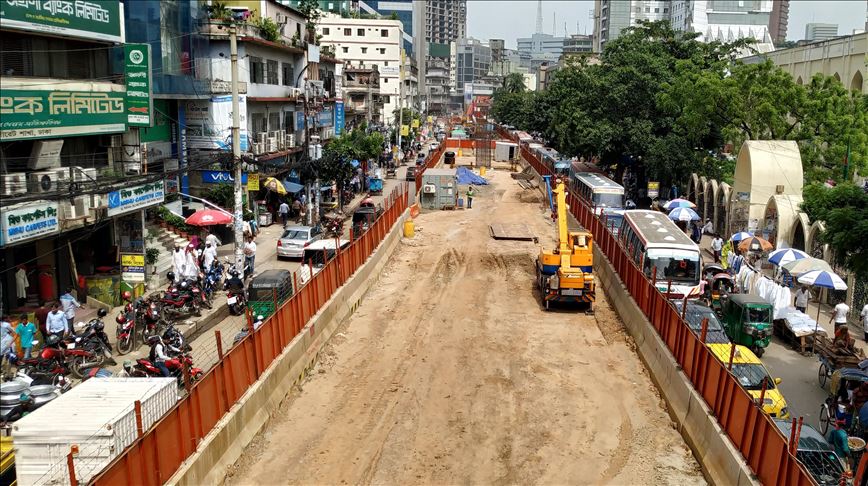Metro rail to speed up life in Bangladeshi capital
Lack of land management to make mega project less viable for overall traffic system, says transport expert

DHAKA, Bangladesh
Around one-third of Bangladesh’s first elevated metro rail project in Dhaka city has been completed.
The project will contribute to easing transportation for over 15 million people of the city, one of the world’s most densely populated capitals infamous for unbridled traffic jam.
"Till August 2019, we have been able to complete 30% of the project’s Line-6," MAN Siddique, managing director of the project, told Anadolu Agency.
According to official information the light metro project has six routes which is mentioned as "Line" and the construction of line-6 is underway.
Siddique said that they hoped to complete all six lines of the project by 2030.
The Mass Rapid Transit project, popularly known as Dhaka Metro Rail Line-6, will run from Uttara adjacent to cities’s international airport to main business hub Motijheel, through significant areas of the city.
The project costs around 220 billion Bangladeshi taka ($2.6 billion) of which the Japan International Cooperation Agency is providing $1.9 billion at 0.01% interest rate, while the rest would come from internal sources.
The construction work is going on in full swing aiming to be completed by the end of 2021, Obaidul Quader, road transport and bridges minister said at a recent seminar in Dhaka on planned timeframe of the project.
The metro line-6 consist of 16 elevated stations and the 20-km-long electricity-powered light rail tracks from Uttara to Motijheel.
Time-consuming
The fast metro line will carry 60,000 passengers in an hour running through each of the 16 stations once in every four minutes, Siddique said, placing the progress report.
Once the metro is in operation, city dwellers would enjoy the much-awaited ease in the traffic movement and getting rid of the rampant traffic jam, he added.
It is also expected that people could reach Matijeel from Uttara within 38 minutes which currently takes more than two hours due to gridlock on roads.
Financial benefit
The project will save $2.4 billion (200 billion takas) a year, equivalent to 1.5% of GDP and 17% of the total tax revenue of Bangladesh, the Daily Star reported on April 30, 2018, citing a government estimation.
Traffic jam causes colossal economic loss for Bangladesh, and Dhaka ranks at the top in incurring the loss, according to reports.
The traffic congestion in Dhaka is causing a loss of $4.4 billion annually, which is equal to 11% of the national budget, according to a study by Accident Research Institute (ARC) at the Bangladesh University of Engineering and Technology (BUET) in 2018.
"Bangladesh could have saved $2.6 billion if it had reduced 60% of traffic congestion in Dhaka," ARC Director Moazzem Hossain said in a report unveiling in the program.
A World Bank report in 2017 on Dhaka’s traffic jam estimated that city dwellers are facing a waste of 3.8 million work hours daily due to the traffic jam.
Siddique said that the metro project will change the look of Dhaka city and play a revolutionary role in city's traffic system.
Skepticism
Speaking to Anadolu Agency, many inhabitants living in Dhaka city for years expressed skepticism over the outcome of the metro-rail project.
"The metro-rail line is being constructed using space of the existing roads. As a result, space of the running roads is being congested," Moksedul Kamal Babu, a decades-long resident of Dhaka’s Shantinagar area, told Anadolu Agency.
Number of city inhabitants is increasing in Dhaka with migration and birth while the number of vehicles is also on the rise. So the traffic jam on the roads may increase even after the launch of the metro rail, Delwar Hossain, a private car driver in city’s Uttara area, told Anadolu Agency.
"The ongoing MRT project will meet only 17% transportation demand of Dhaka city while 40% of the population will use public and private buses and the rest depends on private cars, rickshaw, ride-sharing and other means," Shamsul Haque, a transportation expert and professor of civil engineering at BUET, told Anadolu Agency.
Only those coming to the commercial area (Motijheel) from a particular distance will enjoy traffic-jam-free trips, he said.
Referring to the rising trend of ride-sharing, he said people's addiction to it is also growing as people can very easily move from their residence to other locations by ride-sharing.
"So it is very tough to divert that huge number of people to metro rail", the expert said.
Besides, in most cases passengers of metro rail have to get down in footpaths due to lack of space for good station management.
Pointing to the weakness in planning, he added: "Government is implementing the project merely as a part of traffic management system, but it should have been done as a part of urban development management".
"The project will actually help some people for station-to-station trips, but it will help little to improve the overall traffic system of Dhaka city," he said.
Metro rail will also occupy 10 feet (3 meters) space of the main roads, Haque said, adding that although it’s not a big figure, it is a problem for an overcrowded city like Dhaka.
"When one development hampers another development, it is not a real development," he stressed.









